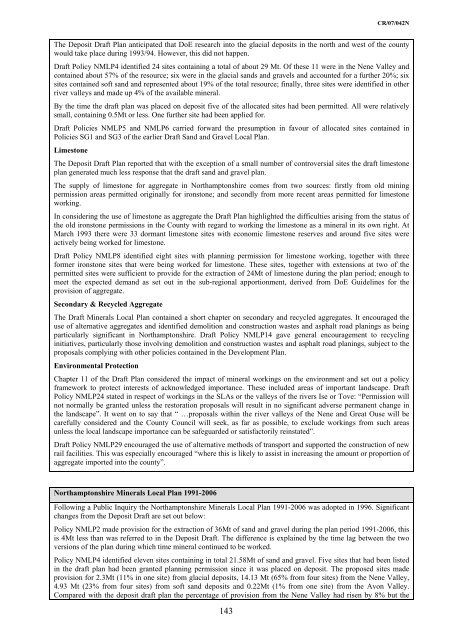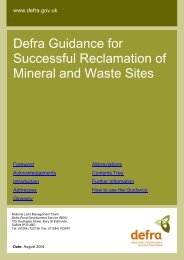Full Report - Sustainable Aggregates
Full Report - Sustainable Aggregates
Full Report - Sustainable Aggregates
Create successful ePaper yourself
Turn your PDF publications into a flip-book with our unique Google optimized e-Paper software.
CR/07/042N<br />
The Deposit Draft Plan anticipated that DoE research into the glacial deposits in the north and west of the county<br />
would take place during 1993/94. However, this did not happen.<br />
Draft Policy NMLP4 identified 24 sites containing a total of about 29 Mt. Of these 11 were in the Nene Valley and<br />
contained about 57% of the resource; six were in the glacial sands and gravels and accounted for a further 20%; six<br />
sites contained soft sand and represented about 19% of the total resource; finally, three sites were identified in other<br />
river valleys and made up 4% of the available mineral.<br />
By the time the draft plan was placed on deposit five of the allocated sites had been permitted. All were relatively<br />
small, containing 0.5Mt or less. One further site had been applied for.<br />
Draft Policies NMLP5 and NMLP6 carried forward the presumption in favour of allocated sites contained in<br />
Policies SG1 and SG3 of the earlier Draft Sand and Gravel Local Plan.<br />
Limestone<br />
The Deposit Draft Plan reported that with the exception of a small number of controversial sites the draft limestone<br />
plan generated much less response that the draft sand and gravel plan.<br />
The supply of limestone for aggregate in Northamptonshire comes from two sources: firstly from old mining<br />
permission areas permitted originally for ironstone; and secondly from more recent areas permitted for limestone<br />
working.<br />
In considering the use of limestone as aggregate the Draft Plan highlighted the difficulties arising from the status of<br />
the old ironstone permissions in the County with regard to working the limestone as a mineral in its own right. At<br />
March 1993 there were 33 dormant limestone sites with economic limestone reserves and around five sites were<br />
actively being worked for limestone.<br />
Draft Policy NMLP8 identified eight sites with planning permission for limestone working, together with three<br />
former ironstone sites that were being worked for limestone. These sites, together with extensions at two of the<br />
permitted sites were sufficient to provide for the extraction of 24Mt of limestone during the plan period; enough to<br />
meet the expected demand as set out in the sub-regional apportionment, derived from DoE Guidelines for the<br />
provision of aggregate.<br />
Secondary & Recycled Aggregate<br />
The Draft Minerals Local Plan contained a short chapter on secondary and recycled aggregates. It encouraged the<br />
use of alternative aggregates and identified demolition and construction wastes and asphalt road planings as being<br />
particularly significant in Northamptonshire. Draft Policy NMLP14 gave general encouragement to recycling<br />
initiatives, particularly those involving demolition and construction wastes and asphalt road planings, subject to the<br />
proposals complying with other policies contained in the Development Plan.<br />
Environmental Protection<br />
Chapter 11 of the Draft Plan considered the impact of mineral workings on the environment and set out a policy<br />
framework to protect interests of acknowledged importance. These included areas of important landscape. Draft<br />
Policy NMLP24 stated in respect of workings in the SLAs or the valleys of the rivers Ise or Tove: “Permission will<br />
not normally be granted unless the restoration proposals will result in no significant adverse permanent change in<br />
the landscape”. It went on to say that “ …proposals within the river valleys of the Nene and Great Ouse will be<br />
carefully considered and the County Council will seek, as far as possible, to exclude workings from such areas<br />
unless the local landscape importance can be safeguarded or satisfactorily reinstated”.<br />
Draft Policy NMLP29 encouraged the use of alternative methods of transport and supported the construction of new<br />
rail facilities. This was especially encouraged “where this is likely to assist in increasing the amount or proportion of<br />
aggregate imported into the county”.<br />
Northamptonshire Minerals Local Plan 1991-2006<br />
Following a Public Inquiry the Northamptonshire Minerals Local Plan 1991-2006 was adopted in 1996. Significant<br />
changes from the Deposit Draft are set out below:<br />
Policy NMLP2 made provision for the extraction of 36Mt of sand and gravel during the plan period 1991-2006, this<br />
is 4Mt less than was referred to in the Deposit Draft. The difference is explained by the time lag between the two<br />
versions of the plan during which time mineral continued to be worked.<br />
Policy NMLP4 identified eleven sites containing in total 21.58Mt of sand and gravel. Five sites that had been listed<br />
in the draft plan had been granted planning permission since it was placed on deposit. The proposed sites made<br />
provision for 2.3Mt (11% in one site) from glacial deposits, 14.13 Mt (65% from four sites) from the Nene Valley,<br />
4.93 Mt (23% from four sites) from soft sand deposits and 0.22Mt (1% from one site) from the Avon Valley.<br />
Compared with the deposit draft plan the percentage of provision from the Nene Valley had risen by 8% but the<br />
143
















